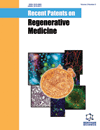Recent Patents on Regenerative Medicine - Volume 4, Issue 1, 2014
Volume 4, Issue 1, 2014
-
-
Review of Patents and Commercial Opportunities Involving Mesenchymal Stromal Cells (MSCs) Therapies in Osteoarthritis
More LessAuthors: Sowmya Viswanathan and Alejandro Gomez-AristizabalOsteoarthritis (OA) is a degenerative joint disease that affects cartilage, subchondral bone, the synovium and synovial fluid and has limited treatment options. With an ageing population and growing health economic costs, novel treatment options for OA are urgently needed. Mesenchymal stromal cells (MSCs) with their demonstrated abilities to modulate pain and inflammation, and with their ability to contribute to chondrocyte differentiation and proliferation are therefore being investigated globally for their potential to provide novel treatment options for OA patients. In this paper, we review the preclinical studies and early clinical trials, and the patent landscape for the use of MSCs for the treatment of OA.
-
-
-
Neurogenesis from Stem Cells
More LessAuthors: Veronica R. Fortino, Devon Pawley, Nastasja Ecker, Zenith Acosta, Juan A. Kochen and Herman S. CheungThis review discusses the present field of neurogenesis using adult stem cells. The authors highlight different methods of differentiating adult stem cells into neural cells: Growth factor and chemical induction, transfection, scaffold and/or 3D culture, and bioreactor and external stimuli. These different methods will be discussed using relevant patents and recent (< 5 year) scientific literature. Additionally, the authors present where they believe the future of neurogenesis from stem cells is headed - the use of neural crest stem cells as the ideal cell source for neurogenesis.
-
-
-
Recent US Patents on Extracellular Matrix in Tissue Engineering and Regenerative Medicine
More LessUS patents relating to compositions containing extracellular matrix material and methods of using extracellular material in tissue engineering and regenerative medicine are being granted at rapid pace. This article briefly describes some of these US patents and their claims. The large number of patents being issued on extracellular material and its uses indicates that there remains strong commercial interest and innovation in this area of tissue engineering and regenerative medicine.
-
-
-
Biomedical Applications of Poly(Lactic Acid)
More LessPolylactic acid (PLA) is a biodegradable, biocompatible, non-toxic and eco-friendly polymer. PLA and its composites are currently used in medical implants, tissue engineering, orthopedic devices, drug delivery systems, etc. The present review highlights recent research and patents for the utility of PLA based polymers and their blends in biomedical applications.
-
-
-
Recent Patents in Cartilage Regeneration
More LessAuthors: Luminita Labusca, Udo Greiser, Viorel Nacu, Florin Zugun-Eloae and Kaveh MashayekhiThe limited capability of articular cartilage to heal after injury and the worldwide increase in the burden of diseases related to osteoarthritis, are prompting numerous efforts in developing novel treatments. Methods of grafting, promoting tissue repair or regenerative medicine strategies are in different stages of investigation. However, in the last decades, inadequate few novel therapies have made their way to the clinic gaining limited acceptance. Some of the reasons of the relative lack of progress are the insufficient quality and stability of the repair tissue and the lack of serious evidence based medicine information to support the use and reimbursement of new procedures. This paper introduces the most recent patents which relate to cartilage regeneration. Grafting procedures and their conceptual development, regenerative medicine strategies as well as drug, physical and food supplements based methods are listed. Main issues encountered with every intervention type and the way new methods are addressing them, are also discussed.
-
-
-
Nanog Overexpression Increases Neural Marker Expression in Adipose Derived Stem Cells
More LessAuthors: Jacob Kimmel and Kiminobu SugayaHuman neural stem cells (hNSCs) have shown potential in treating a variety of neurological diseases. However, they are impractical to isolate and use for an autologous transplant, generating demand for an alternative source of neural phenotypes. Utilizing our patented technology, adipose derived stem cells (ADSCs) may be a potential alternative source, as they are easily isolated and may have the potential to efficiently differentiate into neural phenotypes through transfection of the Nanog gene. ADSCs were transfected with a plasmid containing Nanog. Post-transfection, relative expression levels of Sox2, Oct4, and Nanog were assessed by qPCR. Transfected ADSCs were cocultured for 15 days with differentiated hNSCs using coculture inserts. Following coculture, levels of β-III-tubulin and glial fibrillary acidic protein (GFAP) were assessed by qPCR. Nanog transfected ADSCs expressed significantly increased levels of Nanog, Oct4, and Sox2 prior to coculture, indicating an increase in differentiation potential. Post-coculture, Nanog transfected ADSCs expressed significantly increased levels of β-III-tubulin and GFAP and spherical morphology, indicating an increased neural phenotype. These results demonstrate the effectiveness of our patented technology, suggesting that induced Nanog overexpression may provide a means to more readily generate neural phenotypes for use in transplantation based therapies.
-
Volumes & issues
Most Read This Month


